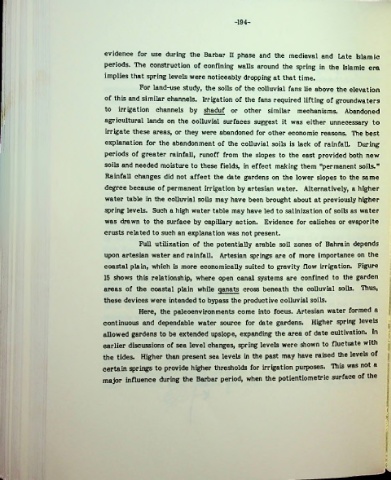Page 218 - Life & Land Use on the Bahrain Islands (Curtis E Larsen)
P. 218
-194-
evidence for use during the Barbar H phase and the medieval and Late Islamic
periods. The construction of confining walls around the spring in the Islamic era
implies that spring levels were noticeably dropping at that time.
For land-use study, the soils of the colluvial fans lie above the elevation
of this and similar channels. Irrigation of the fans required lifting of groundwaters
to irrigation channels by shaduf or other similar mechanisms. Abandoned
agricultural lands on the colluvial surfaces suggest it was either unnecessary to
irrigate these areas, or they were abandoned for other economic reasons. TTie best
explanation for the abandonment of the colluvial soils is lack of rainfalL During
periods of greater rainfall, runoff from the slopes to the east provided both new
soils and needed moisture to these fields, in effect making them "permanent soils."
Rainfall changes did not affect the date gardens on the lower slopes to the same
degree because of permanent irrigation by artesian water. Alternatively, a higher
water table in the colluvial soils may have been brought about at previously higher
spring levels. Such a high water table may have led to salinization of soils as water
was drawn to the surface by capillary action. Evidence for caliches or evaporite
crusts related to such an explanation was not present.
Full utilization of the potentially arable soil zones of Bahrain depends
upon artesian water and rainfall. Artesian springs are of more importance on the
coastal plain, which is more economically suited to gravity flow irrigation. Figure
15 shows this relationship, where open canal systems are confined to the garden
areas of the coastal plain while qanats cross beneath the colluvial soils. TTius,
these devices were intended to bypass the productive colluvial soils.
Here, the paleoenvironments come into focus. Artesian water formed a
continuous and dependable water source for date gardens. Higher spring levels
allowed gardens to be extended upslope, expanding the area of date cultivation. In
'
earlier discussions of sea level changes, spring levels were shown to fluctuate with
the tides. Higher than present sea levels in the past may have raised the levels of
TTiis was not a
certain springs to provide higher thresholds for irrigation purposes,
major influence during the Barbar period, when the potientiometric surface of the
j
i
;
1
ki

